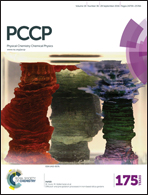The flow patterning capability of localized natural convection†
Abstract
Controlling flow patterns to align materials can have various applications in optics, electronics, and biosciences. In this study, we developed a natural-convection-based method to create desirable spatial flow patterns by controlling the locations of heat sources. Fluid motion in natural convection is induced by the spatial fluid density gradient that is caused by the established spatial temperature gradient. To analyze the patterning resolution capability of this method, we used a mathematical model combined with nondimensionalization to correlate the flow patterning resolution with experimental operating conditions. The nondimensionalized model suggests that the flow pattern and resolution is only influenced by two dimensionless parameters,  and
and  , where Gr is the Grashof number, representing the ratio of buoyancy to the viscous force acting on a fluid, and Pr is the Prandtl number, representing the ratio of momentum diffusivity to thermal diffusivity. We used the model to examine all of the flow behaviors in a wide range of the two dimensionless parameter group and proposed a flow pattern state diagram which suggests a suitable range of operating conditions for flow patterning. In addition, we developed a heating wire with an angular configuration, which enabled us to efficiently examine the pattern resolution capability numerically and experimentally. Consistent resolutions were obtained between the experimental results and model predictions, suggesting that the state diagram and the identified operating range can be used for further application.
, where Gr is the Grashof number, representing the ratio of buoyancy to the viscous force acting on a fluid, and Pr is the Prandtl number, representing the ratio of momentum diffusivity to thermal diffusivity. We used the model to examine all of the flow behaviors in a wide range of the two dimensionless parameter group and proposed a flow pattern state diagram which suggests a suitable range of operating conditions for flow patterning. In addition, we developed a heating wire with an angular configuration, which enabled us to efficiently examine the pattern resolution capability numerically and experimentally. Consistent resolutions were obtained between the experimental results and model predictions, suggesting that the state diagram and the identified operating range can be used for further application.


 Please wait while we load your content...
Please wait while we load your content...